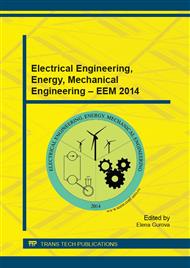[1]
A.V. Panfilov, The current state and prospects of development of cast aluminum matrix reinforced with discrete-composite materials. Caster Russia. 7 (2008) 23-28.
Google Scholar
[2]
A.P. Amosov, V.I. Nikitin, K.V. Nikitin, S.A. Ryazanov, A.A. Ermoshkin, Scientific and technical basis for the use of self-propagating high-temperature synthesis processes for creating cast aluminum matrix composite alloys discretely reinforced with nano-sized ceramic particles of high-tech materials technology and nanotechnology. 8 (2013).
Google Scholar
[3]
A.V. Petrunin, A.V. Panfilova, A.A. Panfilov, On the influence of modification by nanodimensional refractory particles on the structure and properties of aluminum matrix composites. Foundry production. 10 (2009) 17-20.
Google Scholar
[4]
V.I. Napalkov, S.V. Mahov, Alloying and modification of aluminum and magnesium, MISIS, Moscow, 2002, 376. (in Russian).
Google Scholar
[5]
O.V. Anisimov, Development of aluminum-based metal composites strengthened by nanoparticles of refractory compounds, News of universities, Powder metallurgy and the functional coverings. 3 (2011) 33-39.
Google Scholar
[6]
G.A. Kosnikov, V.A. Baranov, S. Yu. Petrovich, Foundry nano-structural composition alumo-matrix alloys. Foundry production. 2 (2012) 4-9.
Google Scholar
[7]
G.A. Libenson, V. Yu. Lopatin, G.V. Komarnitsky, Processes of powder metallurgy, The textbook for high schools in 2 parts, MISIS, Moscow, 2001, 684.
Google Scholar
[8]
I.E. Ignatiev, Yu.V. Kontsevoi, E.V. Ignatieva, E.A. Patukhov, Analysis of the main factors that determine the density of the powder compact, News of universities, Powder metallurgy and functional coatings. 3 (2010) 11-15.
Google Scholar
[9]
E.N. Osokin, Powder metallurgy process, IPK SFU, Krasnoyarsk, 2008, 421.
Google Scholar
[10]
Yu.N. Stepanov, S.A. Tikhomirov, Fluctuation melting and the initial stage of nanopowder sintering, Russian metallurgy (Metally). 3 (2007) 179-183.
DOI: 10.1134/s0036029507030032
Google Scholar
[11]
I. Chang, Y. Zhao, Advances in powder metallurgy: Properties, processing and applications. Woodhead Publishing Limited, 2013, 604.
Google Scholar
[12]
A.A. Bukaemskii, E.N. Fedorova, Explosive compaction and low-temperature sintering of alumina nanopowders. Combustion, Explosion, and Shock Waves. 44, (2008) 717-728.
DOI: 10.1007/s10573-008-0108-8
Google Scholar
[13]
N.G. Kolbasnikov, Theory of metal forming. Physical basis of the strength and ductility of metals. St. Petersburg State Polytechnical University, 2004, 268.
Google Scholar
[14]
Yu.N. Stepanov, M.I. Alymov, E.I. Evstratov, Effect of temperature on the shrinkage rate of compacts composed of nanoparticles. Glass Physics and Chemistry. 31 (2005) 337-339.
DOI: 10.1007/s10720-005-0065-1
Google Scholar
[15]
Yu.N. Stepanov, Features the initial stage of sintering of nanopowders with the oxidized surface. Physics and chemistry of materials processing. 6 (2010) 51-55.
Google Scholar
[16]
G.G. Krushenko, The role of particles of nanopowders when forming structure of aluminum alloys. Metallurgy of mechanical engineering. 1 (2011) 20-24.
Google Scholar


